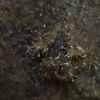
02-01-2026 17:43
MARICEL PATINOHi there, although I couldn't see the fruitbody, I

04-01-2026 17:45
 Stephen Martin Mifsud
Stephen Martin Mifsud
I was happy to find these orange asmocyetes which

03-01-2026 13:08
Niek SchrierHi all,We found groups of perithecia on a Lecanora

29-12-2025 17:44
Isabelle CharissouBonjour,J'aimerais savoir si d'autres personnes au

01-01-2026 18:35
Original loamy soil aside a artificial lake.The co

31-12-2025 19:27
Collected from loamy soil, at waterside (completel
Preparation and methods: Three apothecia examined, stored in a damp box at room temperature for ~1-3 days, still vital, sections mounted in tap water, considerable squashing was required to separate the cells of the hymenium, IKI or KOH and CR added to water mount.
Habitat: Several groups found on exposed parts of inner bark (cork cambium?) of Betula pendula, ~0.5-2 m from the ground, on a dead branch with diameter ~15 cm, seemingly xeric, still attached to the dead trunk, trunk lying on the ground, generally damp area but no bodies of water in immediate vicinity, mixed deciduous woodland, southern England, late February, after wet weather.
Associates: Dematiaceous fungi, algae, immature bryophytes, many small mites feeding on the apothecia.
Apothecia: Scattered to subgregarious, occasionally 2-5 caespitose, pale yellowish-chlorinaceous, translucent, diameter < ~1 mm, superficial, waxy to slightly gelatinous appearance, texture soft-gelatinous, generally thin, concentric rings of differing thickness/translucency often developing on inner flanks, when immature usually deeply cupulate and often with obconical stipe, becoming broader and flatter, usually remaining deeply to shallowly cupulate, occasionally more flat, sessile to substipitate, margin undifferentiated from receptacle and sometimes slightly raised or in-rolled, margin often slightly uneven/undulating in larger mature apothecia, disc mostly concave but sometimes flatter (related to general curvature), disc more waxy-translucent and whitish, central dark patch due to translucency, usually with faint white subiculum around base. When dry, receptacle retracting, dingy orangish, more opaque, subiculum more conspicuous.
Asci: 8-spored, cylindrical to subclavate, apex rounded to hemispherical, base with croziers and no perforations observed, spores vertically oriented, possibly some inversely oriented, protruding slightly from epithecium when mature, IKI -.
• Vital mature (turgid): ~25-30 x 4-5 µm, no apical thickening, pars sporifera ~30-40(60)%, 3-5 seriate, spores in two groups of 4 or 5 above and 3 below.
• Dead mature (presumed, flaccid, in KOH): ~18-25 (27) x 3-4.5 µm, apex sometimes more acute and truncate, pars sporifera ~90%, 2-3 seriate, possibly small apical thickening ~0.5 µm but could be remains of gelatinous matrix.
Spores: Narrow-cylindrical to allantoid-fusiform, poles rounded to obtuse, mostly homopolar but sometimes one pole slightly larger, sometimes slightly inequilateral, mostly straight but rarely slightly curved, 1 (-2?) globose SBs and several LBs at each pole, SB diameter ~0.5 µm, aseptate.
• Spores discharged in water mount and released in squash mount (similar measurements):
(5.4) 5.9- 7.9 (8.2) × (1) 1.1-1.28 (1.3) µm, Q = (4.2) 4.8-7.1 (8), N = 38, Me = 7 × 1.2 µm, Qe = 6.
Paraphyses: Size similar to asci, cylindrical, apex uninflated to narrowly-capitate, large chlorinaceous VBs, mostly 2 septate?, apical cell longer ~1.5-2x.
Subhymenium: Lots of relatively large globose cells, LBs in Brownian motion.
Exudate: Forming epithecium and coating margin and flanks of receptacle, yellowish, darker orangish in median view, ~0.5-1 µm thick but occasionally slightly thicker on receptacle, appears grainy in surface view on receptacle but not apparent for epithecium.
Gelatinous matrix: Hyaline, difficult to separate (firmly conglutinated).
Ectal exc: Textura angularis-prismatica, hyaline, cells parallel to surface, variable cell lengths, external cells appearing thick-walled/gelatinised in surface view, marginal cells not extending much beyond hymenium, marginal apical cells cylindrical-clavate and relatively narrow ~3.5-7.5 µm.
Medullary exc: Like ectal but more uniform cell size and textura globosa-prismatica.
Subiculum: Abundant anchoring hypha around base, hyaline, basal cells swollen below.
In-vitro anamorph
Conidiophores: Dactylella-like, brachyphoris-like, abundantly projecting from substrate and apothecia, conidia seem easily detached, monoblastic, only rare branching observed and none with conidia attached, a few measured ~85 µm long.
Conidia: Large phragmoconidia, cylindrical-fusiform, (2) 5-6 (8) septa, heteropolar, apex rounded-hemispherical, base tapering to truncate hilum, no budding, multiguttulate, LBs (remaining in KOH), VBs, SCBs, vital cells with dextrinoid conidioplasm, occasionally a dead central cell with no visible contents, rarely fragmented at a central cell, when mature seem to germinate within ~6 hours in tap water.
• Vital mature (presumed, contents or germination): ~35-55 x 7-9 µm, apex often tapering more.
• Immature/juvenile (presumed, still attached or <= 3 septa): ~20-30 x 5-7 µm, apex often more hemispherical-truncate, no observed germination.
Germinating conidia: 2-3 (4) cells germinating, often from polar cells, seems like one hypha from each germinating cell, hyphae branching infrequently, hyphal anastomosis observed and twice appearing to involve hyphae from different conidia, some spherical objects of varying size and detritus caught on hyphae when left in water.

The marginal cells appear to be intermediary as narrow is 3-5 and wide is 7-11.
I noticed some similar conidia in Orbilia, and the anamorphic description of section Neodactylella seems fitting. Looking at the Chen et al. (2007) paper on genus Dactylella, the anamorph looks similar to species in the non-predatory clade and most like D. clavata. I guess this has no known teleomorph.
The conidiophores were growing on apothecia and raised parts of the substrate (see photo).

The conidia of O. cardui also seem shorter in general, although the shape and contents of conidia in the monograph drawings does look the same.




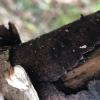
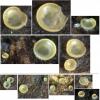


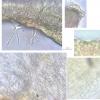
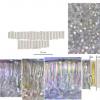

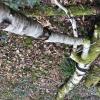
 Hymenium-2-0001.jpeg
Hymenium-2-0001.jpeg